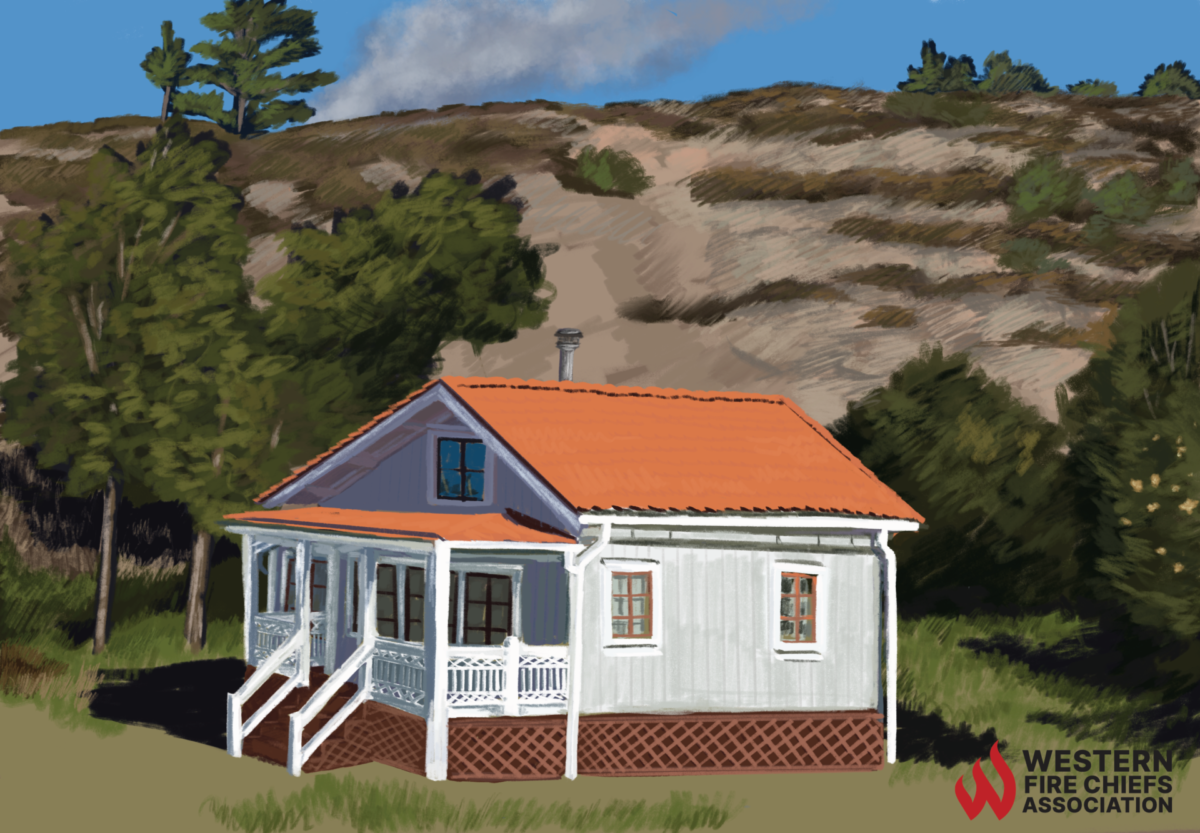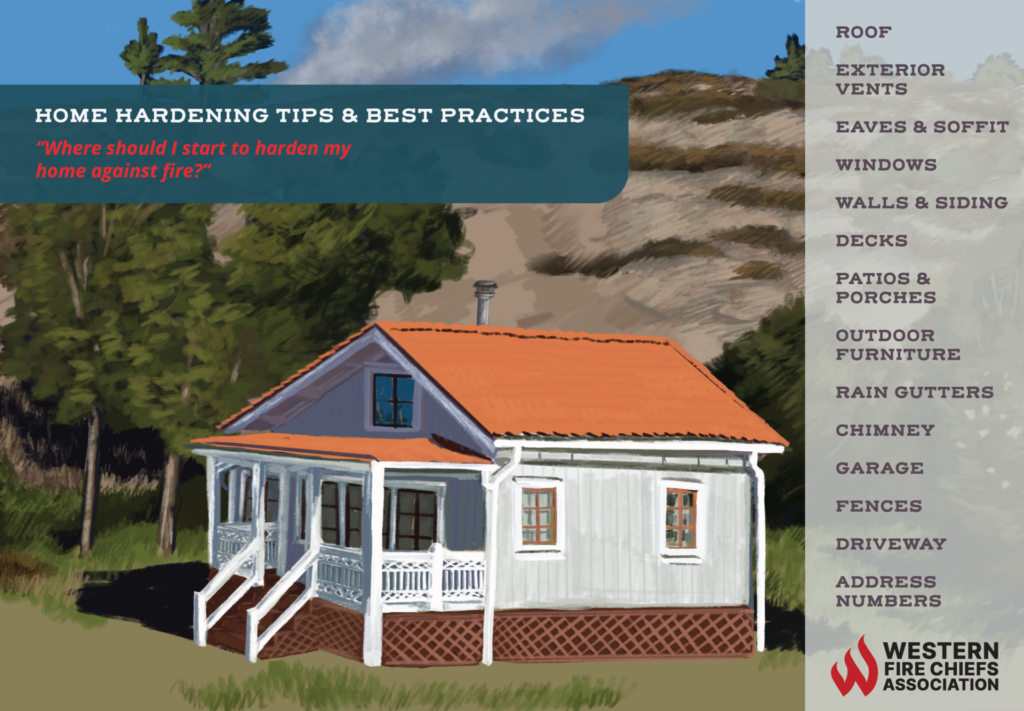Fire Pit Safety Tips
Stay safe around the campfire with tips from the Western Fire Chiefs Association. Learn essential precautions and practices for a worry-free outdoor campfire.
Learn how to harden your home against wildfires with guidance and best practices from the Western Fire Chiefs Association (WFCA).
Published:July 29, 2022
Edited:March 4, 2024

Learn how to harden your home against wildfires with guidance and best practices from the Western Fire Chiefs Association (WFCA).
Home hardening is the process of preparing your home for the possibility of wildfires. It involves setting up defensive measures around your house and the surrounding property, which will help protect it from flames or embers.
Homes can ignite from wildfires in three ways.1
Of the three, wildfire destroys houses most often from flying embers.2 Your home may still be at risk, even if you live far away from the wildfire or a burning structure. Embers can travel for several miles in the air, land on a flammable object or structure (such as a house that has not been home hardened), and catch fire.3
The goal for hardening your home is not just to protect the structure from being destroyed, but also to create a defensible space which increases your chances of escape and acts as a shelter against an encroaching fire.
Low density of fuels around your home can buy precious time if a fire is approaching. However, depending on the weather conditions and location of the fire, you may not be able to evacuate in time. The flames may cut off road access, or the fire may simply be moving too fast. At this point, your house is no longer just a home. It is a refuge, a fortress against fire.
Even if you do not live near or in a high-risk wildfire zone, make home hardening a priority because fires can happen at any time. For example, cooking fires accounted for 49% of all house fires between 2015-2019.4 All it takes is leaving the stove on or not properly tending to the barbecue pit.
It may not be your home that catches fire first; it could be your neighbor’s. In this case, all it would take is a few stray embers to sail on a gust of wind toward your roof or another structure on your property. Without home hardening, the risks to your property from fire are far greater.

The first thing to know is that there are certain areas of your home’s exterior that are especially vulnerable.5 Focus your home hardening tips and best practices on these vulnerabilities. These are your outer defenses, and if an ember or flames penetrate them, your entire house and your property immediately becomes at risk.
Your roof should be made of materials that are fire-resistant. These include composition, metal, clay, or tile. Wood or shingle roofs are far more likely to catch fire, so if you have one of these, it is best to get it replaced.
Block up any spaces between the roof decking and covering. Lastly, you should keep your roof clean of debris that could catch fire, such as dry leaves, moss, and trash.
Vents are like highways into your home for embers. To stop embers from getting inside, install coverings on your vents made of 1/16 to 1/8-inch metal mesh.
Protect your eaves by boxing them in, such as with the soffit-eave design. Use materials that are fire-resistant and won’t easily catch fire.
Your windows are extremely vulnerable to cracking from the heat of a wildfire. To minimize the chance of breakage, install dual-paned windows and make sure one of them is made of tempered glass, which will resist heat more effectively.
In addition, install metal screens on the inside. That way, if the windows do break, the embers from the fire will still be stopped before they can enter your home.
If the walls and siding of your house are made of regular wood, then they are not fire-resistant. Replace them with siding materials made of fiber cement, stucco, or wood that is pre-treated to be fire resistant.
Make sure the siding connects from the very bottom of the foundation all the way up to the roof to prevent flames and embers from slipping through.
Your deck should be made of noncombustible materials. Furthermore, it should be kept clear of flammable objects both above and underneath. If the underside of the deck is exposed, consider installing metal mesh around all the open sides to prevent embers from reaching underneath.
Your patio or porch cover should be made of the same fire-resistant material as your roof.
Purchase outdoor furniture that is made of materials that will resist catching fire.
With rain gutters, the best thing you can do is periodically clear them of debris that could catch fire. You can also purchase a non-combustible gutter cover to help prevent the buildup of debris and makes it easier to maintain.
If you have a stovepipe or chimney, cover the opening with metal mesh with holes that are at least 3/8-inch wide, but not any wider than 1/2-inch. This will protect your home from embers entering from the outside, while also keeping embers from a fire in your fireplace on the inside of the chimney.
Buy some weather stripping and install it all around your garage doors to harden it against flames and embers. Store all your flammable liquids and objects away from the door to reduce the chance they will catch fire, should an ember slip through. If you have windows or vents leading out, cover them with metal mesh.
If you have a fence, separate it from your house or make sure it’s made of fire-resistant materials.
Your driveway should be wide enough to allow emergency vehicles, such as fire engines, to pass through unobstructed. Keep all trees and bushes trimmed back so they do not catch on large vehicles that may pass through. If you have a gate, make sure it opens inward to allow for easier access.
Always make sure that your address number is clearly visible from the street. This way, firefighters will be able to find your house easily, should you need to call them for help.
Below are some additional home hardening resources to help you maintain maximum protection for yourself, your loved ones, and your property.
Stay safe around the campfire with tips from the Western Fire Chiefs Association. Learn essential precautions and practices for a worry-free outdoor campfire.
Discover essential firework safety tips to ensure a dazzling display without accidents. Learn how to celebrate responsibly with expert guidance from WFCA.
Explore the role of AI in wildfire prediction with guidance from the WFCA. Learn how advanced algorithms and data analytics enhance early detection and response.